|
|
CES Technical Report 129, June 2013 |
AN APPRAISAL AND CONSERVATION STRATEGIES FOR THE PTERIDOPHYTES OF UTTARA KANNADA
|
Distribution of Pteridophytes in various taluks of Uttara Kannada district
Table 1: Distribution of Pteridophytes in various taluks of Uttara Kannada district
| Sr. No. |
Botanical name |
Jo |
Ka |
Ye |
Sir |
Ku |
Sid |
Habitat and Ecology |
| 1 |
Huperzia hamiltonii (Spreng) Trev.
(Lycopodiaceae) |
|
|
|
|
|
+ |
Usually growing as epiphytes along shaded stream banks and road sides. |
| 2 |
Lycopodiella cernua (L.) Pic. Ser.
(Lycopodiaceae) |
|
+ |
|
|
+ |
|
Commonest species of Lycopodiaceae found usually along fully exposed road sides, road cuttings and on mud walls. |
| 3 |
Selaginella delicatula (Desv.) Alston
(Selaginellaceae) |
+ |
|
|
|
|
|
Common on stone walls or rock crevices along road sides. |
| 4 |
Selaginella miniatospora (Dalz.) Baken
(Selaginellaceae) |
+ |
|
|
|
|
|
Usually growing on moist, shady soils. |
| 5 |
Selaginella proniflora (Lam.) Baker
(Selaginellaceae) |
|
+ |
|
|
|
|
|
| 6 |
Selaginella tenera (Hook. &Grev.) Spring
(Selaginellaceae) |
|
+ |
|
+ |
|
|
Usually growing as terrestrials on the forest floor in shade and rarely seen along shaded roadsides. |
| 7 |
Ophioglossum costatum R. Br.
(Ophioglossaceae) |
|
+ |
+ |
+ |
+ |
|
Terrestrials in mixed deciduous forests. |
| 8 |
Ophioglossum reticulatum L.
(Ophioglossaceae) |
|
+ |
|
|
|
|
Gregarious on a swampy, grassy spot in a shrub-savanna. |
| 9 |
Angiopteris indica Desv.
(Marattiaceae) |
+ |
|
|
|
|
|
Usually common along shaded stream banks. |
| 10 |
Osmunda huegeliana Presl.
(Osmundaceae) |
+ |
|
|
|
+ |
+ |
Terrestrial plants growing as large colonies or bushes in fully exposed in fully exposed marshy places near streams or lakes. |
| 11 |
Lygodium flexuosum (L.) Sw.
(Schizaeaceae) |
+ |
+ |
+ |
+ |
+ |
+ |
Terrestrial, growing as climbers along fully or partially exposed roadsides. |
| 12 |
Lygodium microphyllum (Cav.) R. Br.
(Schizaeaceae) |
+ |
|
|
|
|
|
Growing as climbers on trees in fully exposed marshy places. |
| 13 |
Acrostichum aureum L.
(Pteridaceae) |
|
+ |
|
|
+ |
|
Gregarious in tidal backwaters in fully exposed places. |
| 14 |
Pteris biaurita L.
(Pteridaceae) |
+ |
|
|
|
|
|
Usually seen along roadsides in fully exposed places. |
| 15 |
Pteris linearis L.*
(Pteridaceae) |
+ |
|
|
|
|
|
Usually found on stream banks |
| 16 |
Pteris pellucid Presl.
(Pteridaceae) |
+ |
+ |
+ |
|
|
+ |
Normally growing inside the forests in fully shaded places, rarely seen on roadsides and partially exposed places. |
| 17 |
Pteris quadriaurita Retz.
(Pteridaceae) |
+ |
|
|
+ |
|
+ |
Very common species of Pterisdistributed in variety of habitats. |
| 18 |
Pteris semipinnata L.**
(Pteridaceae) |
+ |
|
|
|
|
|
Found distributed in evergreen forests. |
| 19 |
Pteris vittata L.
(Pteridaceae) |
+ |
|
+ |
|
|
+ |
Usually grows along fully exposed roadsides on stone crevices. |
| 20 |
Cheilanthes tenuifolia (Burm. f.) Sw.
(Sinopteridaceae) |
+ |
+ |
|
|
|
+ |
Gregarious in fully exposed canals at foothills or paddy fields, ponds or other such marshy places. |
| 21 |
Ceratopteris thalictroides (L.) Brongn.
(Parkeriaceae) |
+ |
+ |
|
|
+ |
|
Gregarious in fully exposed canals at foothills or paddy fields, ponds or other such marshy places. |
| 22 |
Pityrogramma calomelanos (L.) Link.
(Hemionitidaceae) |
+ |
|
+ |
|
+ |
+ |
Usually terrestrials, rarely lithophytes along roadsides in fully exposed dry places; rarely along stream banks. |
| 23 |
Adiantum philippense L. subsp. philippense
(Adiantaceae) |
+ |
+ |
+ |
+ |
+ |
+ |
Terrestrial plants usually seen along partially or fully exposed roadsides. |
| 24 |
Vittaria elongata Sw.
(Vittariaceae) |
|
|
+ |
|
|
|
Growing as epiphytes from sea level to 1200 m height. |
| 25 |
Microlepia speluncae (L.) Moore
(Dennstaedtiaceae) |
|
|
|
|
|
+ |
Grow as terrestrials on forest floor or along shaded stream banks. |
| 26 |
Pteridium revolutum (Blume) Nakai Syn. P. aquilinum(L.) Kuhn.
(Dennstaedtiaceae) |
+ |
|
|
|
|
|
Gregariously growing on fully exposed grassy slopes on the forest edge, roadsides and clearings. |
| 27 |
Lindsaea ensifolia Sw.
(Lindsaeaceae) |
+ |
|
|
+ |
|
|
Terrestrials, commonly seen on fully exposed dry places, seen rarely on fully shaded places. |
| 28 |
Lindsaea heterophylla Beddome
(Lindsaeaceae) |
+ |
|
|
|
|
+ |
Commonly found on dry slopes in evergreen forests. |
| 29 |
Leucostegia truncata (D. Don) Fras-Jenk. syn.: LeucostegiaimmersaC. Presl.
(Davalliaceae) |
|
|
|
|
|
+ |
Terrestrial or lithophytes on fully or partially exposed dry places along roadsides, clearings or forest edges between 800 – 1300 m. |
| 30 |
Hymenophyllum polyanthos Sw.
(Hymenophyllaceae) |
+ |
|
|
|
|
|
Epiphytes on tree trunks or mossy rocks in partial or full shade. |
| 31 |
Trichomanes intramarginale Hook. &Grev.
(Hymenophyllaceae) |
|
+ |
|
|
|
|
Epiphytes or lithophytes along shaded stream banks. |
| 32 |
Dicranopteris linearis (Burm. F.) Underwood
(Gleicheniaceae) |
+ |
+ |
+ |
+ |
+ |
+ |
Found extensively growing along the road cuttings in shaded or open areas. |
| 33 |
Cyathea gigantea (Wall. ex Hook.) Holttum
(Cyatheaceae) |
+ |
|
|
|
|
+ |
Found abundantly growing as terrestrial plants along the shaded stream banks. |
| 34 |
Cyathea nilgirensis Holttum
(Cyatheaceae) |
|
|
|
|
|
+ |
This is endemic to South India and is found distributed in central and southern Western Ghats. |
| 35 |
Thelypteris (Ampelopteris) prolifera(Retz.) Copel.
(Thelypteridaceae) |
|
+ |
|
|
|
|
Often found scrambling amongst tall grasses, sedges or shrubs in freshwater swamps, or beside rivers, ponds and lakes. |
| 36 |
Thelypteris(Amphineuron) terminans (Hook.) Holttum
(Thelypteridaceae) |
|
|
+ |
|
|
|
Seen as a colony in forests along partially exposed roadsides and forest edges. |
| 37 |
Thelypteris (Christella) dentate (Forssk) E.P.St.John
(Thelypteridaceae) |
+ |
+ |
|
|
|
|
This is the most common fern in South India. It is found throughout the Western Ghats, along roadsides, clearings and along stream banks in partially or fully exposed places. |
| 38 |
Thelypteris (Christella) hispidula (Decne) Holttum
(Thelypteridaceae) |
|
+ |
|
|
|
|
Growing inside the forest. |
| 39 |
Thelypteris (Christella) papilio (Hope) Holttum
(Thelypteridaceae) |
|
|
|
|
|
+ |
Distributed along stream banks. |
| 40 |
Thelypteris (Christella) parasitica (L.) Tardieu
(Thelypteridaceae) |
+ |
+ |
+ |
|
|
+ |
Very common in partially shaded places in the evergreen forests. |
| 41 |
Thelypteris (Cyclosorus) interrupts (Willd.) H. Ito
(Thelypteridaceae) |
+ |
+ |
|
|
|
|
Usually seen frequently as large colonies in open marshy places, lakes, walls and border of paddy fields from sea level upto 1400 m height. |
| 42 |
Asplenium inequilaterale Willd.
(Aspleniaceae) |
|
|
|
|
|
+ |
Terrestrial on fully shaded or partially exposed streams and stream banks. |
| 43 |
Asplenium phyllitidis subsp. Phyllitidis D. Don
(Aspleniaceae) |
|
|
|
+ |
|
|
Common in moist deciduous forests growing as epiphytes on trees. |
| 44 |
Anisocampium cumingianum Presl.
(Woodsiaceae) |
|
|
|
|
+ |
|
Low altitude terrestrial plants, seen along partially exposed road sides or fully shaded forest floors. |
| 45 |
Athyrium anisopterum Christ
(Woodsiaceae) |
+ |
|
|
|
|
+ |
On humus rich floor of dense evergreen forests. |
| 46 |
Athyrium hohenackerianum (Kuntze) T. Moore
(Woodsiaceae) |
+ |
+ |
|
|
|
|
Less frequent species found to be growing as terrestrials or lithophytes on rock crevices along fully or partially shaded roadsides. |
| 47 |
Athyrium solenopteris (Kuntze) T. Moore
(Woodsiaceae) |
|
|
|
|
|
+ |
This is the most common species of Athyrium and is commonly found along fully shaded stream banks. They also grow on forest floor and in fully exposed marshy places between 1300-2200 m. |
| 48 |
Diplazium esculentum (Retz.) Sw.
(Woodsiaceae) |
+ |
|
|
|
|
+ |
Terrestrial ferns growing as large colonies in open marshy places along streams and canals. |
| 49 |
Dryopteris cochleata (Buch. Ham. ex D. Don) C. Chr.
(Dryopteridaceae) |
+ |
|
|
|
|
|
Terrestrial plants frequently growing along fully exposed roadsides, dry places or clearings. |
| 50 |
Tectaria coadunata (J. Sm.) C. Chr.
(Dryopteridaceae) |
+ |
+ |
|
|
|
|
Frequent along fully or partially shaded roadsides, along waysides inside the forest or on forest floor. |
| 51 |
Tectaria polymorpha (Wallich. Ex Hook.) Copel. |
+ |
|
|
|
|
+ |
On mountain slopes, usually in dry places in dense forests. |
| 52 |
Bolbitis appendiculata (Willd.) K. Iwatz
(Lomariopsidaceae) |
+ |
|
|
|
|
|
Usually growing as lithophytes in large colonies along fully or partially shaded streams or stream banks. |
| 53 |
Bolbitis lancea (Copel.) Ching
(Lomariopsidaceae) |
+ |
+ |
|
|
|
|
|
| 54 |
Bolbitis presliana (Fee) Ching
(Lomariopsidaceae) |
+ |
+ |
|
|
|
+ |
Growing as terrestrials near water bodies and other moist places. |
| 55 |
Bolbitis prolifera (Bory) C. Chr.
(Lomariopsidaceae) |
+ |
|
|
|
|
|
Lithophytes on shaded rocks on the forest floor usually along stream banks. |
| 56 |
Bolbitis semicordata (Bak.) Ching
(Lomariopsidaceae) |
+ |
|
|
|
|
+ |
Usually found as lithophytes growing along shaded stream banks. Endemic to south India. |
| 57 |
Bolbitis subcrenatoides Fras.-Jenk. new name for Bolbitis subcrenata (Benth & Hook.) var. Prolifera (Rev.)
(Lomariopsidaceae) |
+ |
+ |
|
|
|
+ |
Occurs in partially shaded or open road side cuttings in semi-evergreen and evergreen forests. Endemic to South India |
| 58 |
Blechnum orientale L.
(Blechnaceae) |
+ |
+ |
+ |
+ |
+ |
+ |
Terrestrial plants, growing on fully exposed dry places and clearing along roadsides and road cuttings. |
| 59 |
Stenochlaena palustris (Burm.) Beddome
(Blechnaceae) |
|
|
|
|
+ |
|
Usually found along partially shaded roadsides or inside the forest in fully shaded places. |
| 60 |
Drynaria quercifolia (L.) J. Sm.
(Polypodiaceae) |
|
+ |
+ |
+ |
+ |
|
They occur as epiphytes on the bark of trees in partly or fully shaded places. |
| 61 |
Lepisorus nudus (Hook.) Ching
(Polypodiaceae) |
+ |
|
|
|
|
+ |
Commonly seen as epiphytes on shola trees and sometimes also grow as lithophytes along stream banks or on forest floor. |
| 62 |
Leptochilus decurrens Blume
(Polypodiaceae) |
|
+ |
|
|
|
+ |
Terrestrials or lithophytes along fully shaded streams or stream banks. |
| 63 |
Loxogramme involuta (D. Don) Presl
(Polypodiaceae) |
|
|
|
|
|
+ |
Epiphytes or lithophytes growing inside the forest. |
| 64 |
Microsorum membranaceum (D. Don) Ching
(Polypodiaceae) |
|
|
|
|
|
+ |
Epiphytes on fully shaded shola trees inside the forest or on forest edges. |
| 65 |
Microsorum punctatum (L.) Copel.
(Polypodiaceae) |
|
|
|
|
|
+ |
Epiphytes along fully or partially shaded stream banks. |
| 66 |
Marsilea minuta L.
(Marsileaceae) |
+ |
|
|
|
+ |
|
Aquatic or semi-aquatic in ponds, paddy fields and marshy places. |
| 67 |
Azolla pinnata R. Br.
(Azollaceae) |
+ |
|
|
|
+ |
|
Free floating aquatic plants at sea level and plains. |
Jo – Joida; Ka – Karwar; Ye – Yellapur; Sir – Sirsi; Ku – Kumta; Sid – Siddapur;
*A very rare species. Included in the list on the basis of herbarium sheet at BLAT collected by MacCann.
**No specimen has been collected by Rajagopal & Bhat (1998) and in current investigations, information based on earlier literatures.
Botanical name: Huperzia hamiltonii (Spreng) Trev.
Family: Lycopodiaceae
Botanical description: Small plants; stem pendulous, entire plant up to 28 cm long, 4mm thick without leaves; isodichotomously branched; one to three times; leaves numerous, spirally arranged, spreading, oblong or elliptic, margin entire; texture coriaceous; leaves dark green and glabrous. Sporangia borne at the axis of sporophylls towards 5cm long distal-most part of main stem.Sporangia yellowish-brown; spores numerous, trilete.
Distribution and ecology: Growing as epiphytes on shoal trees along shaded stream banks or roadsides. |
Botanical name: Lycopodiella cernua (L.) Pic. Ser.
Family: Lycopodiaceae
Botanical description: Main stem erect, terete, bearing branching roots at the base; entire branching system above the unbranched main stem; main branches subopposite, forked two to three times into secondary branches which bear upto 5 times forked tertiary branches. Leaves sparse on main stem, dense on the rest, acuminate, entire, pale green, herbaceous.Cones terminal on the ultimate branches, pendant, cylindrical; sporophylls yellowish-green, thin. Spores trilete, pale green.
Distribution and ecology: Commonly occurring plant, found along fully exposed road sides, on road cuttings and on muddy walls.
Uses: It is cultivated as an ornamental plant. In Malaysia, decoction of the plant is used as a lotion in beri-beri and also for coughs and uneasiness in the chests (Manickam & Irudayaraj, 1992). |
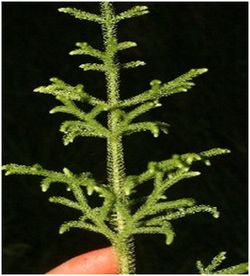 |
Botanical name: Selaginella delicatula (Desv.) Alston
Family: Selaginellaceae
Botanical description: Stem erect or suberect, rooting at the base, upto 4mm thick without leaves; lateral branches many, alternate, tripinnate; leaves oblique and scattered on main stem, arranged in four rows on lateral branches. Spikes borne on ultimate branches, quadrangular; sporophylls uniform, ovate; microspores green, megaspores pale brown.
Distribution and ecology: Common on stone walls or rock crevices along road sides.
|
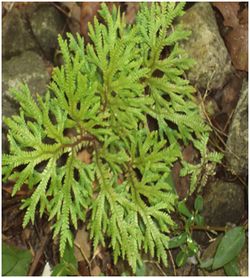 |
Botanical name: Selaginella miniatospora (Dalz.) Baker
Family: Selaginellaceae
Botanical description: Stem about 30 cm long, yellowish-green, branched from the base and rooting at base only. Leaves dimorphic throughout and distant on the main stem; lateral and median leaves ovate and dentate. Sporophylls of spike dimorphic; smaller sporophylls fertile, ovate; larger sporophylls sterile, oblong-ovate. Microspores trilete, pyramidical.
Distribution and ecology: Usually growing on moist, shady soils. |
Botanical name: Selaginella proniflora (Lam.) Baker
Family: Selaginellaceae
Botanical description: Trailing herbs; stem erect-decumbent. Leaves contiguous but obliquely horizontal on main stem; lateral leaves with ciliate margins; arista of median leaves half as long as leaf lamina. Megasporophylls oblong-lanceolate; megaspore reticulate; microspore reticulate with spines. |
Botanical name: Selaginella tenera (Hook. &Grev.) Spring
Family: Selaginellaceae
Botanical description: Stem erect, up to 3mm thick without leaves, up to 8 mm wide with leaves, green to pink colour when fresh. Leaves dimorphic throughout, contiguous on main stem and on axis of primary branches; lateral leaves oblong-ovate; median leaves ovate; sporophylls dimorphic, lateral sporophylls bearing megasporangia, others with microsporangia.
Distribution and ecology: Terrestrials on the forest floor in shade. Rarely seen along road sides and waysides. |
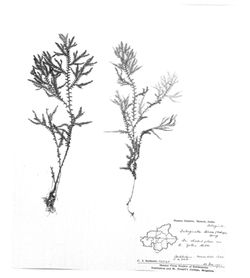 |
Botanical name: Ophioglossum costatum R. Br.
Family: Ophioglossaceae
Botanical description: Rhizome tuberous to 1cm in diameter, bearing numerous fleshy roots. Fronds about 18 cm long; oblong-lanceolate, acute at apex, narrowly cuneate at base; texture rather fleshy, soft herbaceous. Sporophyll simple, with stalks of about 10 cm in length; spikes to 4.5 cm long. Sporangia about 0.5 mm in diameter; spores dark, with rather roughly reticulate exospores.
Distribution and ecology: Terrestrials in mixed deciduous forests. |
Botanical name: Ophioglossum reticulatum L.
Family: Ophioglossaceae
Botanical description: Rhizome erect, cylindrical, tuberous, bearing long, thick, fleshy roots. Petiole dark green, terete, fleshy; blade simple, usually cordate, rarely ovate, entire; distinct midrib absent; blade dark green, glabrous above and below; texture herbaceous. Spike arising from the base of sterile blade. Spore sacs arranged in two alternate compact rows, dehisced by horizontal splits; spores spherical, trilete, colourless with pale green nuclear content.
Distribution and ecology: Terrestrial as small colonies on fully or partially exposed grassy slopes or clearings of Pteridiumrevolutum.
Uses: Fleshy fronds are eaten as vegetable curry (Dixit &Vohra, 1984). Ophioglossumin general is used as a cooling agent and in treatment of inflammations and wounds (Manickam and Irudayaraj, 1992). |
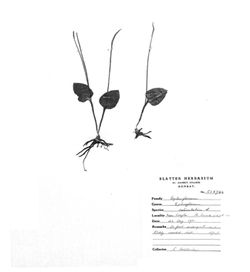 |
Botanical name: Angiopteris indica Desv.
Family: Marattiaceae
Botanical description: Rhizome erect, cylindrical, apex densely covered by dark brown hairs. Lamina deltoid, bipinnate; pinnae up to 16 pairs, sub-opposite, oblong-lanceolate; lamina dark coloured, texture herbaceous, recurrent false veins reaching the soral line.Soralline close to or at the margin and generally has smaller segments with prominent teeth near their tips.
Distribution and ecology: Common along shaded stream banks. |
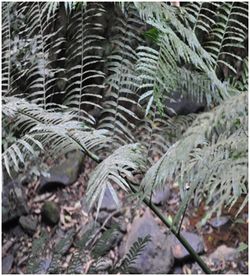 |
Botanical name: Osmunda huegeliana Presl.
Family: Osmundaceae
Botanical description: Rhizome erect or sub-erect, scales absent; stipes tufted, numerous. Lamina lanceolate, bipinnate, distal one-fourth to one-sixth part bearing sporangia; sterile pinnae up to seven pairs, shortly stalked, ascending. Pinnae pale green to rufous brown, glabrous, texture coriaceous; fertile pinnules compressed, panicle forming, cylindrical, bearing large spherical sporangia all over the branches; spores trilete, globose.
Distribution and ecology: Terrestrial plants growing as large colonies or bushes in fully exposed marshy places near streams or lakes.
Uses: Fronds are used as tonic and also for rickets, rheumatism and for intestinal gripping (Dixit, 1959; Dixit and Vohra, 1984). |
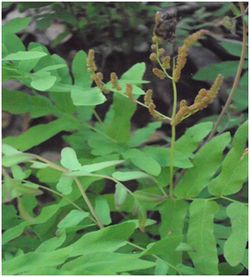 |
Botanical name: Lygodium flexuosum (L.) Sw.
Family: Schizaeaceae
Botanical description: Rhizome short creeping, upto 0.5 cm thick, densely covered by about 1 mm long, dark brown, multicellular, uniseriate, tubular hairs all over. Fronds oblong-lanceolate, tripinnate, primary pinna alternate; pinnules oblong-lanceolate, simple or forked; pinnae pale green, texture herbaceous. Sporangia arranged adaxially, finger-like spikes along the margin of the pinnules; sporangia about five pairs; protected by indusium; spores yellowish-green.
Distribution and ecology: Terrestrials, climber along fully or partially exposed roadsides.
Uses: Young shoots used as leafy vegetables, plants used as an expectorant; rhizome boiled with mustard oil and locally applied in rheumatism, sprains, scabies, ulcers, eczema and cuts (Dixit, 1959; Dixit and Vohra, 1984). |
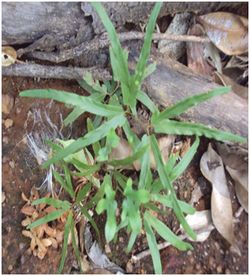 |
Botanical name: Lygodium microphyllum (Cav.) R. Br.
Family: Schizaeaceae
Botanical description: Climber; rhizome long, creeping, covered by dark hairs. Fronds 2-3 m tall; stipe and rachis brown. Primary branches borne up to 10 cm apart on adaxial side of rachis, a pair of secondary branches borne subapically; secondary rachis and stalk of the pinnules narrowly winged above; lateral pinnules up to four pairs, alternate; pinnules pale green, glabrous above and below; texture herbaceous. Sporangia borne on the surfaces of the finger-like lobes all around the margins of the pinnules except at the cordate base.
Distribution and ecology: Not very commonly occurring. Climber on trees in fully exposed marshy places.
Uses: Cultivated in gardens. Young leaves are eaten in Java. Decoction of leaves is given in dysentery. Leaves applied in form of poultices for skin diseases and swellings (Manickam and Irudayaraj, 1992). |
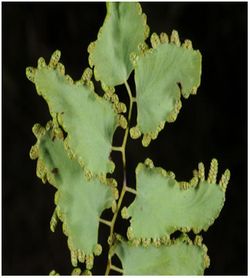 |
Botanical name: Acrostichum aureum L.
Family: Pteridaceae
Botanical description: Rhizome erect, 5 cm thick, densely covered by scales all over. Scales lanceolate, dark brown, thin. Lamina simply pinnate; pinnae up to 11 cm; costa slightly raised, rounded below; pinnae glabrous all over above and below, yellowish-green when fresh, brownish when dry, texture coriaceous; up to six pairs of pinnae in distal part of lamina are fertile; soriacrostichoid, spores trilete.
Distribution and ecology: Gregariously growing in tidal backwaters in fully exposed places.
Uses: In Malaya and Borneo, the rhizome is pounded and grated and applied as a paste to wounds and boils. Rhizome is also used for worms and bladder complaints in China. |
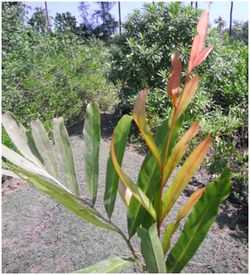 |
Botanical name: Pteris biaurita L.
Family: Pteridaceae
Botanical description: Rhizome erect, upto 3 cm in diameter, densely covered by scales at the apex. Lamina lanceolate, bipinnatifid; pinnae upto 12 pairs, subopposite, shortly stalked, apex acuminate, base broadly cuneate; pinnae pale green, texture subcoriaceous. Sori borne all along the margin except at the base of the sinus and at the apex of the lobe; spores dark brown, exine with dense reticulate thickenings.
Distribution and ecology: Usually seen along roadsides on fully exposed places. |
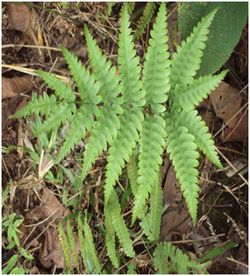 |
Botanical name: Pteris pellucid Presl.
Family: Pteridaceae
Botanical description: Rhizome erect, up to 3cm thick, densely scaly at apex. Stipe up to 45 cm long,abaxially rounded, adaxially grooved, glossy and glabrous all over. Lamina broadly obovate, simply pinnate with ternate apex; pinnae pale green, glabrous above and below, often glossy on the upper surface; texture coriaceous.Sori linear marginal except at the apex and base, indusiate; indusial dark brown, entire, glabrous; spores trilete, tetrahedral, yellowish-brown.
Distribution and ecology: Growing normally inside the forest, in fully shaded places, rarely seen on the forest edges or roadsides in partially exposed places.
|
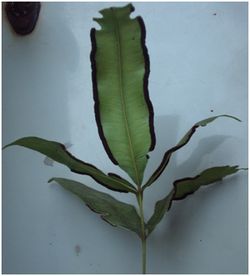 |
Botanical name: Pteris quadriaurita Retz.
Family: Pteridaceae
Botanical description: Rhizomeerect or suberect, 2.5 cm thick; scales lanceolate; stipes pale brown, glabrous, glossy above. Lamina deltoid or broadly ovate, bipinnatifid; pinnae 5-10 pairs, opposite, 5 cm apart, lanceolate; basal pinnae forked once at the base; pinnae dark green; texture thick, herbaceous to subcoriaceous.
Distribution and ecology: Most common species of Pteris distributed in all kinds of habitats.
|
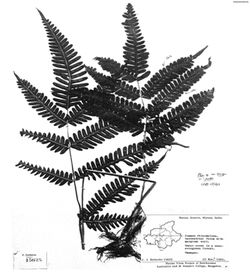 |
Botanical name: Pteris vittata L.
Family: Pteridaceae
Botanical description: Rhizome suberect, 5 cm thick, covered by scales at apex. Stipes tufted, 20 cm long, pale brown, scaly at base. Lamina lanceolate, simply pinnate; pinnae opposite or sub-opposite, sessile, linear lanceolatemargin serrate in distal non-soral part, entire in the rest; pinnae pale green, glabrous; texture herbaceous; sori all along the margin upto the base. Spores yellowish-green.
Distribution and ecology: Growing along fully exposed roadsides in stone crevices.
|
 |
Botanical name: Cheilanthes tenuifolia (Burm. f.) Sw.
Family: Sinopteridaceae
Botanical description: Rhizome short creeping, about 1 cm thick, densely scaly at the apex. Lamina ovate-lanceolate, quadripinnate below, tripinnate at the middle, bipinnate above, apex acuminate, base cuneate; primary pinnae about 5 pairs, ascending, upto 9 cm apart, distinctly stalked; pinnae dark green, glabrous above and below. Sori marginal on each ultimate lobe; protected by reflexed margin; spores dark brown; exine granulose.
Distribution and ecology: Gregarious in fully exposed canals or paddy fields, ponds or other such marshy places between sea level to 100 m.
Uses: Rhizome and roots are used by the tribals as a general tonic (Dixit, 1959).
|
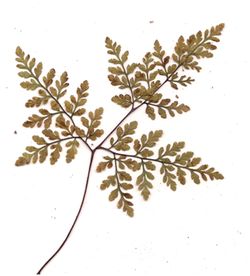 |
Botanical name: Ceratopteris thalictroides (L.) Brongn.
Family: Parkeriaceae
Botanical description: Aquatic plants; stock erect or sub-erect, bearing thick, fibrous, fleshy roots densely on abaxial side, apex covered by scales. Fronds arranged in a rosette; stipes fleshy, pale green. Lamina dimorphous, primary pinnae about five pairs, slightly ascending, alternate, shortly stalked. Lamina glabrous above and below, pale green; texture soft, herbaceous. Fertile lamina ovate, tripinnate, margin reflexed and completely covering lower surface on which two rows of larger sporangia are borne; spores trilete, pale green.
Distribution and ecology: Gregarious in fully exposed canals at foothills, paddy fields, ponds and other such marshy places.
Uses: Fronds are used as poultice in skin complaints and in China as tonic. Fresh leaves are used as vegetable curry (Dixit and Vohra, 1984).
|
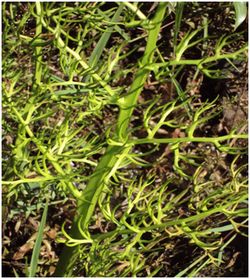 |
Botanical name: Pityrogramma calomelanos (L.) Link.
Family: Hemionitidaceae
Botanical description: Rhizome erect, about 3 cm thick, densely scaly at apex; scales lanceolate. Lamina lanceolate, bipinnate, apex acute or acuminate, base broadly cuneate, pinnae about 12 pairs, progressively reduced towards the apex, dark green, glabrous and glossy above, covered by silver coloured waxy powder below, texture thin or thick herbaceous. Sori along veins, covered by entire surface when mature; spores trilete, honey coloured, exine densely, minutely papillose.
Distribution and ecology: Usually terrestrial, rarely lithophytes along roadsides in fully exposed dry places.
Uses: Widely cultivated as an ornamental pot plant.
|
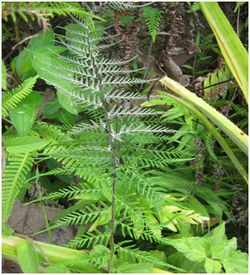 |
Botanical name: Adiantum philippense L. subsp. philippense
Family: Adiantaceae
Botanical description: Rhizome erect or sub-erect, scales oval shaped, pale brown at periphery while dark brown in centre part; Leaf lamina lens shaped, simply pinnate with 10-17 pairs of fan shaped pinnae; margin entire or subcrenate in sterile pinnae, pale green coloured pinnae and herbaceous texture. Sori along the edge of the lobe in continuity. Spores triangular shaped.
Distribution and ecology: This species is more or less uniformly distributed across the Western Ghats from the southern to northern parts. These are terrestrial plants commonly seen along partially or fully exposed roadsides.
Uses: The leaf and root decoction is used effectively for the treatment of chest complaints in Malaya (Benjamin &Manickam, 2007).
|
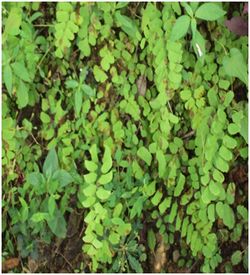 |
Botanical name: Vittaria elongata Sw.
Family: Vittariaceae
Botanical description: Rhizome short, creeping, branched, densely clothed by scales all over. Fronds about 2 mm apart, linear-oblong lanceolate, progressively narrowing towards the base and apex; fronds dark green, texture chartaceous, flexous. Sori marginal, erect when mature, spores monolete, ellipsoid, pale yellowish-green.
Distribution and ecology: Growing as low altitude epiphytes in forests.
Photo source: http://rbg-web2.rbge.org.uk
|
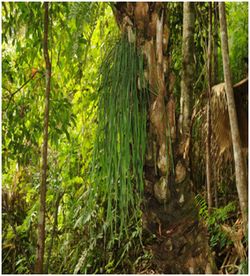 |
Botanical name: Microlepia speluncae (L.) Moore
Family: Dennstaedtiaceae
Botanical description: Rhizome long, creeping, branched upto 2 cm thick, densely clothed by pale brown, multicellular, uniseriate, tubular hairs all over. Lamina broadly deltoid, ovate, tripinnatifid, primary pinnae about 8 pairs, Secondary pinnae about 20 pairs, slightly ascending; Lamina usually pubescent above and below, dark green, texture soft, herbaceous. Sorisubmarginal, usually on the basal acroscopic vein end of each lobe; spores trilete, pale green, triangular with rounded corners.
Distribution and ecology: Grow as terrestrials on forest floor or along shaded stream banks, rarely found along shaded road sides. |
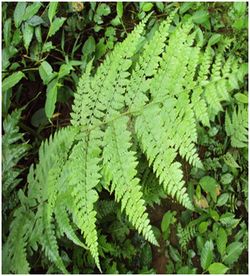 |
Botanical name: Pteridium revolutum (Blume) Nakai Syn. P. Aquilinum (L.) Kuhn.
Family: Dennstaedtiaceae
Botanical description: Rhizome long creeping, subterranean, upto 2 cm thick, densely covered by pale brown, multicellular, uniseriate, deciduous hairs all over. Lamina deltoid-ovate, acute, broadly cuneate, tripinnatifid at base, becoming bipinnatifid at apex; primary pinnae about 8 pairs, opposite or subopposite; lamina dark green, texture coriaceous.Sori linear, submarginal, about 1 mm wide.
Distribution and ecology: Gregariously growing on fully exposed grassy slopes on the forest edge, roadsides and clearings.
Uses: Rhizome is astringent, anthelmintic and is useful in diarrhea and inflammation of gastric and intestinal mucous membranes. Rhizome is boiled in oil and is made into ointment for wounds. The dried fronds are employed as packaging materials. Also used in floral decorations.
|
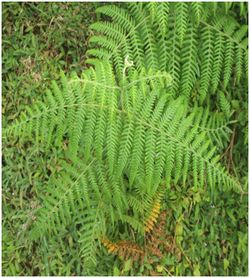 |
Botanical name: Lindsaea ensifolia Sw.
Family: Lindsaeaceae
Botanical description: Rhizome up to 3 mm thick branched, densely covered by scales all over. Stipes scattered, glossy and glabrous all over. Lamina obovate, simply pinnate with terminal pinna similar to lateral ones; pinnae one to six pairs, shortly stalked, margin entire in fertile pinnae, finely serrate or wavy or entire in sterile ones; texture herbaceous. Sori linear continuous or interrupted, all along the margin except at the very base, indusiate; spores dark brown.
Distribution and ecology: Terrestrial, commonly seen on fully exposed dry places, seen rarely on fully shaded places.
Photo source: http://rbg-web2.rbge.org.uk
|
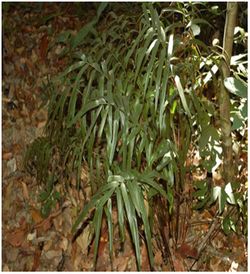 |
Botanical name: Lindsaea heterophylla Beddome
Family: Lindsaeaceae
Botanical description: Rhizome up to 3 mm thick often branched, densely covered by scales all over. Stipes scattered, tetragonal, glabrous and glossy. Lamina deltoid or ovate, bipinnate, pinnules up to 10 pairs, alternate, shortly stalked, margin usually entire, no distinct midrib; pinnules dark green, glabrous above and below; texture herbaceous. Sori sub-marginal, continuous all along the margin except at the cuneate base, discontinuous in lobed ones; indusial pale green, margin crenate; spores pale brown, exine granulose.
Distribution and ecology: On dry slopes in evergreen forests, not in open areas, at various altitudes.
|
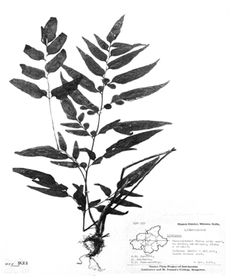 |
Botanical name: Leucostegia truncata (D. Don) Fras-Jenk. syn.: Leucostegia immerse C. Presl.
Family: Davalliaceae
Botanical description: Rhizome long creeping, upto 5 mm thick, densely covered by scales and hairs all over. Lamina ovate, bipinnatified or tripinnate, apex acute, base cuneate; primary pinnae upto eight pairs; lamina yellowish-green, glabrous above and below, texture soft and herbaceous. Sorisubmarginal on the basal acroscopic lobe of the pinnule at the vein end, more or less orbicular, distinctly raised on upper surface of pinnule.
Distribution and ecology: Terrestrial or lithophytes on fully or partially exposed dry places along roadsides, clearings or forest edges between 800 – 1300 m.
Uses: Young fronds are cooked with potato and eaten with rice in Darjeeling district of West Bengal (Dixit and Vohra, 1984).
|
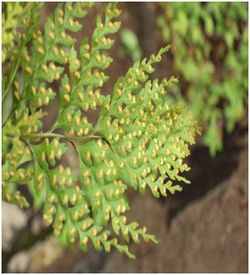 |
Botanical name: Hymenophyllum polyanthos Sw.
Family: Hymenophyllaceae
Botanical description: Rhizome slender, with hairy rootlets. Stipes sparsely hairy especially in the younger parts, rootlets densely hairy.Laminae very variable both in size and form, lanceolate, oblong-lanceolate, usually tripinnatifid, light green, herbaceous. Rachis winged throughout, entire, flat, pinnae less than 10 in pairs. Sori scattered usually in the upper parts of fronds.
Distribution and ecology: Epiphytes on tree trunks or mossy rocks in partial or full shade, common at medium or higher altitudes.
Photo source: http://rbg-web2.rbge.org.uk
|
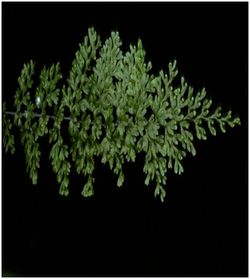 |
Botanical name: Trichomanes intramarginale Hook. & Grev.
Family: Hymenophyllaceae
Botanical description: Rhizome wide creeping, up to 1mm thick, profusely branched. Fronds scattered, , dark hairy stipe, broadly, obliquely obovate in outline, pinnatifid or subpinnatifid, outer margin almost rounded; ultimate segments oblong; lamina dark green, membranaceous. Sori terminal on the segments, immersed, laterally winged; spores spherical, ovoid or elliptic.
Distribution and ecology: Epiphytes or lithophytes along shaded stream banks.
|
Botanical name: Dicranopteris linearis (Burm. F.) Underwood
Family: Gleicheniaceae
Botanical description: Rhizome long, creeping, densely covered by ferruginous hairs. Lamina about 30 cm to few meters long, erect or scandant, forked once to several times, bearing accessory branches at or above the forks; ultimate leafy segments oblong, pinnatifid almost to the costa. Sori median or submedian, orbicular, exindusiate; sporangia dehiscing vertically; spores trilete, exine smooth.
Distribution and ecology: extensively growing along the road cuttings in shaded or open areas.
Uses: The rhizome is used as anthelmintic in Assam while the fronds are used for asthma in Madagascar. The splints are prepared by cracking the outer covering of the long leaf stalks and pulling out the ribbon-like vascular bundles which are woven into mats, chair seats, punches, caps, fishing traps, coiled baskets and belts (Manickam&Irudayaraj, 1992).
|
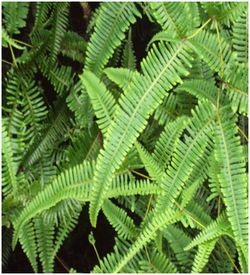 |
Botanical name: Cyathea gigantea (Wall. ex Hook.) Holttum
Family: Cyatheaceae
Botanical description: Trunk about 9 cm in diameter, about a meter high with persistent swollen bases of stipes, bearing crown of fronds at the apex; trunk densely covered by scales. Lamina bipinnate, deltoid, primary pinnae about 12 pairs, spreading, alternate, distinctly stalked, oblong-lanceolate, apex acuminate, base truncate or subtruncate. Sori media on the veins, three to five and half pairs, spherical, forming two zigzag rows submarginally, sporangia numerous, compact; paraphyses mingled with sporangia.
Distribution and ecology: Found abundantly growing as terrestrial plants along the shaded stream banks. |
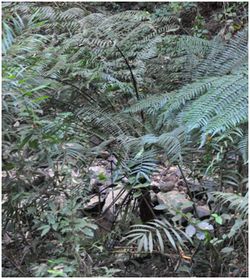 |
Botanical name: Cyathea nilgirensis Holttum
Family: Cyatheaceae
Botanical description: Trunk about 2 m high, bearing crown of fronds at the apex; scales densely covering the younger fronds, lanceolate, dark brown at centre and orange coloured at periphery, apex hair pointed. Lamina bipinnate, oblong-lanceolate, about 200 x 100 cm, acute; pinnae about 12 pairs, alternate, distinctly petiolate; basal few pairs slightly reduced; pinnules acuminate, base truncate or subtruncate, margin pinnatifidupto the costa. Sori seated at the vein forks of the lower half of the segments, spherical, exindusiate, paraphyses intermingled with sporangia, spores trilete.
Distribution and ecology: This is endemic to South India and is found distributed in central and southern Western Ghats.
|
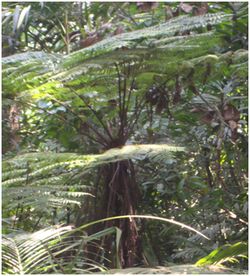 |
Botanical name: Thelypteris (Ampelopteris) prolifera (Retz.) Copel.
Family: Thelypteridaceae
Botanical description: Large scrambling herb, rhizome short-creeping. Leaves closely spaced, arching; petiole pale brown, glabrous; lamina narrowly lanceolate to narrowly elliptical; pinnae numerous, subsessile, margin crenate. Sori circular to elongate, 4–12 on each side of the pinna lobe, without indusium, at maturity uniting with adjacent sori.
Distribution and ecology: Often found scrambling amongst tall grasses, sedges or shrubs in freshwater swamps, or beside rivers, ponds and lakes.
|
Botanical name: Thelypteris (Amphineuron) terminans (Hook.) Holttum
Family: Thelypteridaceae
Botanical description: Rhizome wide creeping, bearing scales densely at the apex; scales linear lanceolate, uniformly thickened. Stipes tetragonal with a shallow groove on either side, dark brown and densely scaly at the base, glabrous above. Lamina simply pinnate, pinnae up to 25 pairs, ascending, shortly stalked or subsessile; texture herbaceous; thin, soft, acicular hairs distributed densely on the lower surface of rachis, costa, veins and intervenal area. Sori up to 10 pairs, strictly confined to the margin of the lobes; spores monolete, dark brown.
Distribution and ecology: Usually seen as a colony in the forests along partially exposed roadsides and forest edges.
Photo Source – ASEAN Tropical Plant Database
|
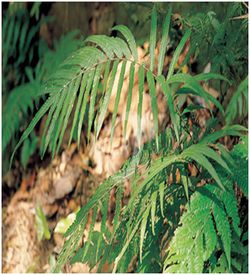 |
Botanical name: Thelypteris (Christella) dentate (Forssk) E.P.St.John
Family: Thelypteridaceae
Botanical description: Rhizome short to long creeping, upto 1 cm thick, sparsely scaly; scales lanceolate. Lamina oblong-lanceolate; pinnae upto 20 pairs with upto 10 pairs of progressively reduced basal pinnae, reduced basal pinnae opposite or subopposite, unreduced pinnae alternate. Sori median on veins, upto six pairs; spores brown, exine with elongate, thick ridges.
Distribution and ecology: This is the most common fern in South India. It is found throughout the Western Ghats, along roadsides, clearings and along stream banks in partially or fully exposed places.
|
.jpg) |
Botanical name: Thelypteris (Christella) hispidula (Decne) Holttum
Family: Thelypteridaceae
Botanical description: Rhizome short creeping; stipes 44 cm long and 0.7 cm thick, grey-brown at base, stramineous above, glabrous. Lamina simply pinnate throughout; pinnae about 20 pairs, sessile, subopposite; basal two pairs slightly reduced, pinnae in distal part of the lamina progressively reduced; lower surface of pinnae and rachis with slightly shorter and often capitate hairs. Sori about five pairs, median on veins; indusial reniform, densely covered by acicular hairs.
Distribution and ecology: Growing inside the forests.
|
Botanical name: Thelypteris (Christella) papilio (Hope) Holttum
Family: Thelypteridaceae
Botanical description: Rhizome erect, up to 3 cm thick; scales lanceolate, pale brown. Stipes tufted, grey-green, glabrous above, scaly at the base. Lamina lanceolate, pinnae up to 31 pairs, alternate or subopposite, few pairs of basal most pinnae reduced to tubercules; pinnae pale green, glabrous all over, above and below. Sori median, on two to six pairs of basal veins.
Distribution and ecology: Not very frequent, occurring along stream banks.
|
Botanical name: Thelypteris (Christella) parasitica (L.) Tardieu
Family: Thelypteridaceae
Botanical description: Rhizome long creeping, rarely erect; rhizome scales linear-lanceolate. Lamina deltoid, broadly ovate or cordate; rachis copiously covered by long and short hairs; pinnae upto 13-20 pairs, opposite at base, subopposite or alternate at distal part; basal pinnae upto 3 cm apart; pinnae pale green. Sori median or submarginal on the veins, upto 5 pairs, often only the lowermost vein bearing the sori, indusial densely hairy.
Distribution and ecology: Very common in partially shaded places in the evergreen forests.
|
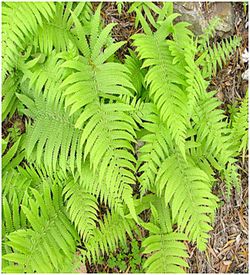 |
Botanical name: Thelypteris (Cyclosorus) interruptus (Willd.) H. Ito
Family: Thelypteridaceae
Botanical description: Rhizome wide creeping, profusely branched, scaly at the apex; scales ovate. Lamina elliptic lanceolate, simply pinnate; pinnae upto 27 pairs, subopposite or alternate, basal pinnae not reduced; few pairs of pinnae in the distal part of lamina abruptly reduced; upper surface of pinnae glabrous; texture chartaceous; lamina pale green; sori median on the veins, upto eight pairs in two rows arranged in v-shape; soriindusiate; spores monolete, ellipsoid, pale brown, exine finely spinulose.
Distribution and ecology: Usually occurring frequently as large colonies in open marshy places, lakes, walls and borders of paddy fields.
|
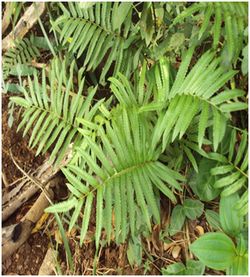 |
Botanical name: Asplenium inequilaterale Willd.
Family: Aspleniaceae
Botanical description: Rhizome erect or suberect, up to 1 cm thick, covered by scales at the apex; scales ovate-lanceolate. Stipes tufted, grey-brown to pale brown, glabrous. Lamina oblong to ovate-lanceolate, simply pinnate; pinnae up to 20 pairs, gradually reduced in the distal part of the frond, basal pinnae not reduced; pinnae alternate or subopposite, shortly stalked; pinnae dark green, glabrous; texture herbaceous. Sori up to 10 pairs; spores planoconvex or reniform with densely, irregularly anastomosed ridges on the surface.
Distribution and ecology: Terrestrial on fully shaded or partially exposed streams and stream banks.
|
Botanical name: Asplenium phyllitidis subsp. Phyllitidis D. Don
Family: Aspleniaceae
Botanical description: Epiphytic or lithophytic. Similar to Aspleniumnidus L., differing from it in: rhizome scales brown, broader; frond up to 80 by 7 cm (in exceptional cases up to 10 cm broad); midrib raised below; soriusually reaching more than half-way to margin, often occupying 3/4 of the length of veins
Distribution and ecology: Epiphytes on mossy trunks or lithophytes on muddy rocks in dense evergreen forests.
|
Botanical name: Anisocampium cumingianum Presl.
Family: Woodsiaceae
Botanical description: Rhizome short creeping, up to 0.8 cm, densely clothed by scales all over. Stipes scattered, pale green when fresh, stramineous when dry, scaly at base, glabrous above. Lamina ovate or ovate-lanceolate, simply pinnate; pinnae up to 10 pairs, slightly ascending, shortly stalked; pinnae dark green, glabrous above and below; texture herbaceous. Sori median on all the veins; indusial very small, pale brown; spores ellipsoid or spherical.
Distribution and ecology: Low altitude terrestrial plants, seen along partially exposed road sides or fully shaded forest floor.
|
Botanical name: Athyrium anisopterum Christ
Family: Woodsiaceae
Botanical description: Terrestrial. Rhizome short, ascending, scaly. Stipes up to 12 cm long, stramineous, dark and scaly at base. Lamina narrowly oblong, pinnate-bipinnatifid; pinnae stalked, oblong to oblong-subdeltoid, lobed nearly half way towards costa; lobes rounded, toothed. Sori medial, round, rather large; indusial round to oblong, opening outwards.
Distribution and ecology: Growing as terrestrials on humus rich floor of dense evergreen forests.
|
Botanical name: Athyrium hohenackerianum (Kuntze) T. Moore
Family: Woodsiaceae
Botanical description: Rhizome erect, upto 2cm thick, densely scaly at the apex; scales linear lanceolate. Lamina elliptic or lanceolate, simply pinnate, gradually narrowed from the middle portion both towards apex and base; pinnae upto 20 pairs, few basalmost pinnae shortly stalked, opposite. Sori median or submedian on the veins, straight or hooked; indusial pale brown, entire; spores globose, yellowish brown, exine with thin undulate winged perispore.
Distribution and ecology: Less frequent species found to be growing as terrestrials or lithophytes on rock crevices along fully or partially shaded roadsides.
|
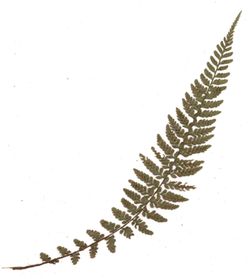 |
Botanical name: Athyrium solenopteris (Kuntze) T. Moore
Family: Woodsiaceae
Botanical description: Rhizome erect, upto 6cm thick, densely clothed by scales all over. Lamina ovate or ovate-lanceolate, about 40 x 20 cm, bipinnate or subtripinnate, apex acuminate; pinnae about 12 pairs, patent or ascending subopposite below, alternate above, upto 6 cm apart, shortly stalked. Sori in two rows close to the costules, usually hooked, rarely straight; upto 2 x 1mm, indusiate.
Distribution and ecology: This is the most common species of Athyrium and is commonly found along fully shaded stream banks. They also grow on forest floor and in fully exposed marshy places between 1300-2200 m.
|
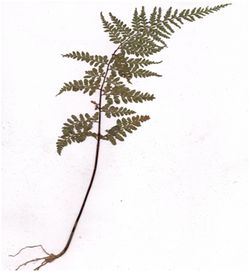 |
Botanical name: Diplazium esculentum (Retz.) Sw.
Family: Woodsiaceae
Botanical description: Rhizome erect, up to 4 cm thick, densely scaly at the apex; scales linear-lanceolate. Stipes tufted, sparsely scaly at the base, glabrous above; purplish bands scattered throughout the stipe and rachis. Lamina deltoid, bipinnate with simply pinnate apex; pinnae up to seven pairs, basal one or two pairs opposite or sub-opposite, rest of the pairs alternate; pinnae dark green, glabrous above and below; texture herbaceous. Sori all along the veins except the base and apex; indusial pale brown with wavy margin.
Distribution and ecology: Terrestrial ferns growing in large colonies in open marshy places along streams and canals.
Uses: Young leaves are cooked as vegetables by the tribals of Uttar Pradesh (Singh et al, 1989). Decoction prepared from rhizome and young leaves is used for haemoptysis and cough in Philippines (Manickam and Irudayaraj, 1992).
|
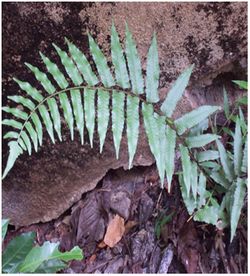 |
Botanical name: Dryopteris cochleata (Buch. Ham.ex D. Don) C. Chr.
Family: Dryopteridaceae
Botanical description: Rhizome short creeping, upto 3 cm thick, densely clothed by scales all over. lamina lanceolate, bipinnate; pinnae upto 10 pairs, ascending, shortly stalked, subopposite, upto 5 cm apart; pinnae pale green; texture subcoriaceous, long, soft. Fertile pinnule oblong, acute, margin lobed more than half way to the costule; lobes upto eight pairs, oblique, apex acute, totthed; sori one per lobe, indusial reniform; spores dark brown.
Distribution and ecology: Terrestrial plants frequently growing along fully exposed roadsides, dry places or clearings.
Uses: The extract of whole plant is given twice daily orally in case of snake bites while the plant paste is applied on the bite wound to prevent infection. A small portion of powdered rhizome is taken with water daily twice for treating rheumatism, epilepsy and leprosy (Singh, 1999; Verma and Singh, 1995).
|
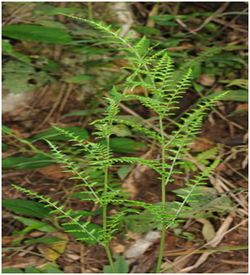 |
Botanical name: Tectaria coadunata (J. Sm.) C. Chr.
Family: Dryopteridaceae
Botanical description: Rhizome short creeping, upto 3 cm thick, densely scaly at the apex; scales ovate-lanceolate. Lamina ovate or broadly ovate, apex acute, base cordate, bipinnate or bipinnatifid, distinct primary pinnae three to five pairs; secondary pinnae about 5 pairs, alternate. Lamina pale green, texture thin, soft herbaceous.Sori on the end of veinlets in two rows along the costules of secondary pinnae; spores pale brown.
Distribution and ecology: Frequent along fully or partially shaded roadsides, along waysides inside the forest or on forest floor.
Uses: Young fronds are used as vegetable curry or as salad; extract from fresh rhizomes is used for preventing diarrhea in children in Darjeeling district (Dixit and Vohra, 1984).
|
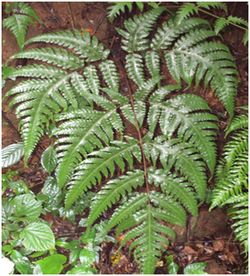 |
Botanical name: Tectaria polymorpha (Wallich. Ex Hook.)
Family: Dryopteridaceae
Botanical description: Rhizome short, ascending to sub-erect, scales linear-subtriangular. Stipesstramineous to brown, glabrescent beneath.Lamina imparipinnate, ovate-oblong; rachis densely pubescent on upper surface, glabrescent beneath; lateral pinnae oblong-lanceolate; shortly stalked or sessile.Sori on cross veins or sometimes on included free veins, irregularly scattered on the lower surface of pinnae; indusia small, pubescent.
Distribution and ecology: On mountain slopes usually in dry places in dense forests at low to medium altitudes.
|
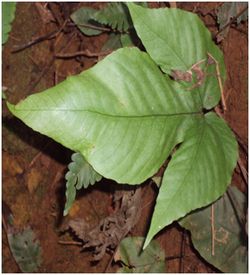 |
Botanical name: Bolbitis appendiculata (Willd.) K. Iwatz
Family: Lomariopsidaceae
Botanical description: Rhizome short creeping, 0.5-1 cm thick, covered by scales at the apex. Sterile lamina lanceolate, simply pinnate, , apex acuminate, base truncate; pinnae upto 25 pairs, dark green when fresh, dark olivaceous when dry, glabrous above and below; texture firm, herbaceous. Fertile pinnae upto 20 pairs, oblong, margin crenate; Soriacrostichoid, covering lower surface, covering the costa when mature, spores monolete, spherical, pale brown.
Distribution and ecology: Usually growing as lithophytes in large colonies along fully or partially shaded streams or stream banks.
Photo source: http://rbg-web2.rbge.org.uk
|
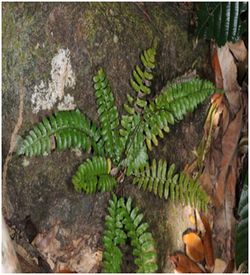 |
Botanical name: Bolbitis lancea (Copel.) Ching
Family: Lomariopsidaceae
A type specimen of this has been found to be a genuine hybrid with abortive spores, from Rumpa hills, Tamil Nadu (Fraser-Jenkins, 2008b). Hennipman (1977) has identified this hybrid as being B. augustipinna x B. semicordata, pending further experimental study.
|
Botanical name: Bolbitis presliana (Fee) Ching
Family: Lomariopsidaceae
Botanical description: Rhizome creeping, scaly. Stipe 15-25 cm long, scaly.Fronds 15-30 cms long, of two kinds, pinnate. Pinnae of the sterile fronds 5-10 cms long, 1.25 cm wide, stalked, narrow, lanceolate, gradually tapering at both ends, entire. Fertile fronds much contracted, surface naked, rachis scaly, more or less winged.
Distribution and ecology: Growing as terrestrials near water bodies and other moist places.
|
Botanical name: Bolbitis prolifera (Bory) C. Chr.
Family: Lomariopsidaceae
Botanical description: Rhizome short creeping, densely scaly all over; scales appressed, ovate-lanceolate. Stipes grey-brown, densely scaly at the base, sparsely scaly above; rachis narrowly winged and scaly throughout; sterile lamina ovate, simply pinnate; pinnae about 10 pairs, subsessile or shortly stalked; pinnae pale green to dark green, glabrous above and below, texture herbaceous to chartaceous. Fertile fronds with slightly longer stipe, fertile pinnae with about eight pairs; soriacrostichoid, spores abortive.
Distribution and ecology: Lithophytes on shaded rocks on the forest floor usually along stream banks.
|
Botanical name: Bolbitis semicordata (Bak.) Ching
Family: Lomariopsidaceae
Botanical description: Rhizome short, creeping, upto 0.4 cm thick, densely scaly at the apex; scales lanceolate, uniformly dark brown. Lamina simply pinnate, narrowly deltoid, progressively narrowed from base to apex, bearing terminal pinna slightly different from others; pinnae glabrous above and below, dark green; texture herbaceous. Fertile pinnules much contracted ones, uptoeigh pairs, alternate, upto 2 cm apart, soriacrostichoid.
Distribution and ecology: Usually found as lithophytes growing along shaded stream banks. Endemic to south India. |
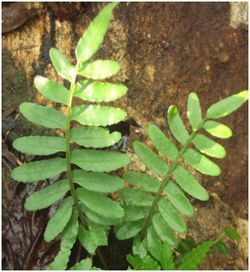 |
Botanical name: Bolbitis subcrenatoides Fras.-Jenk. new name for Bolbitis subcrenata (Benth & Hook.) var. Prolifera (Rev.)
Family: Lomariopsidaceae
Botanical description: Endemic to South India. Much elongated and narrow fertile pinnae; frond apex in mature plants is much elongated and flagellated.
Distribution and ecology: Occurs in partially shaded or open road side cuttings in semi-evergreen and evergreen forests.
|
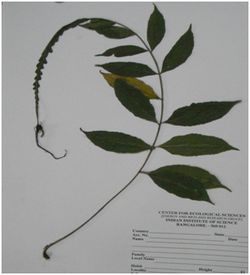 |
Botanical name: Blechnum orientale L.
Family: Blechnaceae
Botanical description: Rhizome erect, upto 12cm thick, densely clothed by scales all over; scales linear-lanceolate, uniformly dark brown. Lamina ovate to linear-lanceolate, apex acute, base subtruncate or broadly cuneate; pinnae 10-56 pairs, spreading or slightly ascending, alternate.Sori linear along either side of the costa, parallel, dark brown, continuous, very rarely interrupted, indusiate; indusial dark brown, firm with entire margin.
Distribution and ecology: Terrestrial plants, growing on fully exposed dry places and clearing along roadsides and road cuttings.
Uses: Fresh fronds are used as a poultice for boils in Malaya; the rhizome is used as an anthelmintic in China, eaten during scarcity of food in Malaya, as cure for intestinal worms, bladder complaints in India, Polynesia and as diaphoretic, aromatic, aperative in Philippines (Dixit and Vohra, 1984). |
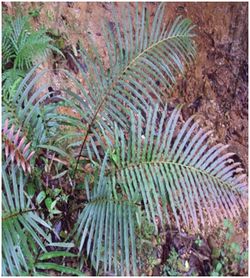 |
Botanical name: Stenochlaena palustris (Burm.) Beddome
Family: Blechnaceae
Botanical description: Rhizome long creeping, scandant, stramineous with few scattered scales, often reaching the top of trees. Fronds scattered, dimorphic; lamina ovate or oblong-lanceolate; pinnae up to 20 pairs, spreading, shortly stalked. Fertile fronds borne at the distal part of the plant or at the interval, more or less of the same size and shape of the steriles one; soriborned all over the lower surface of fertile segments, protected by pale brown, firm, entire, reflexed margin; spores monolete.
Distribution and ecology: Low altitude climber, found along partially shaded roadsides or inside the forest in fully shaded places.
Uses: The young shoots are eaten either raw, as salad or cooked. Owing to their durability when submerged in salt water, the rhizomes are utilized as cordage in binding fish traps and as anchor ropes. They are also used for making baskets (Manickam and Irudayaraj, 1992).
|
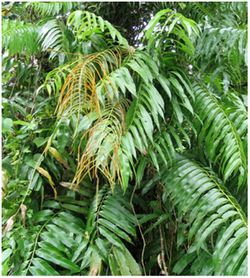 |
Botanical name: Drynaria quercifolia (L.) J. Sm.
Family: Polypodiaceae
Botanical description: Rhizome short creeping, upto 4.5 cm thick, densely clothed by scales. Lamina oblong, pinnately lobed, base decurent; lobes upto 15 pairs, basal pairs much reduced; costa and veins raised above and below, interconnected by veinlets; pinnae pale green, glabrous, texture coriaceous. Sori seated at the juncture of veins, more or less in two rows along each primary vein, exindusiate.
Distribution and ecology: They occur as epiphytes on the bark of trees in partly or fully shaded places.
Uses: Rhizome is bitter and is used as antibacterial, anti-inflammatory, for treating constipation, diarrhea, ulcers and other inflammations. The decoction of plant is used in typhoid fever and fronds are useful in treating swellings (Dixit &Vohra, 1984; Warrieret al, 1996).
|
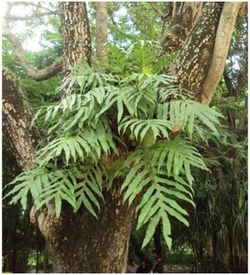 |
Botanical name: Lepisorus nudus (Hook.) Ching
Family: Polypodiaceae
Botanical description: Rhizome long creeping, upto 3 mm thick, branched, densely covered by scales. Laminae simple, linear-elliptic to linear-lanceolate, apex acuminate, base decurrent, narrowly cuneate, margin entire; midrib slightly raised above and below; lamina dark green above, pale green below. Sori superficial; arranged in the distal half of the frond in two rows between margin and midrib; conspicuous, hemispherical, upto 5 mm in diameter.
Distribution and ecology: Commonly seen as epiphytes on shola trees and sometimes also grow as lithophytes along stream banks or on forest floor.
|
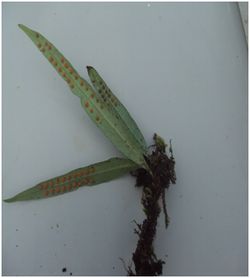 |
Botanical name: Leptochilus decurrens Blume
Family: Polypodiaceae
Botanical description: Rhizome about 0.4 cm thick, densely scaly all over; scales ovate-lanceolate, uniformly pale brown. Stipes up to 5 cm apart, pale brown or stramineous when dry, glabrous; lamina ovate-lanceolate, apex acute or acuminate, base abruptly decurrent. Fertile frond with up to 37 cm long stipe, spores reniform or planoconvex, exine granulose.
Distribution and ecology: Terrestrial or lithophytes along full shaded streams or stream banks.
Photo source: http://rbg-web2.rbge.org.uk
|
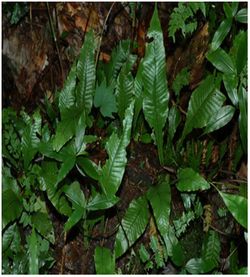 |
Botanical name: Loxogramme involuta (D. Don) Presl
Family: Polypodiaceae
Botanical description: Rhizome long creeping, up to 0.5 cm thick, densely scaly; scales lanceolate, yellowish brown at very base, pale brown in the rest, margin entire. Fronds scattered, elliptic or linear-lanceolate, flattened, margin entire; lamina succulent, pale green or yellowish-green, brittle, glabrous above and below.Sori linear, up to 3 cm long, oblique, parallel up to 17 pairs, mostly in the distal part of the frond; spores monolete, reniform, planoconvex or ellipsoid, yellowish-green with finely granulose exine.
Distribution and ecology: High altitude epiphytes or lithophytes growing inside the forests.
Photo source: http://rbg-web2.rbge.org.uk |
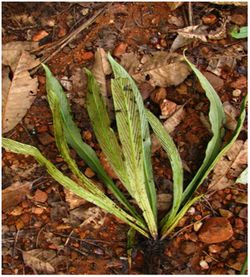 |
Botanical name: Microsorum membranaceum (D. Don) Ching
Family: Polypodiaceae
Botanical description: Rhizome long creeping, up to 0.4 cm thick, sparsely covered by scales. Fronds elliptic or lanceolate, srranged in a single row on the adaxial side of rhizome, up to 1 cm apart, pale brown, distinct stipe, margin entire; pinnae pale green, glabrous all over; texture membranaceous or thin herbaceous. Sori numerous, distributed all over the lower surface of the frond at random; spores yellowish-green; exine finely granulose.
Distribution and ecology: Epiphytes on fully shaded shola trees inside the forest or at the forest edge.
Photo source: http://rbg-web2.rbge.org.uk
|
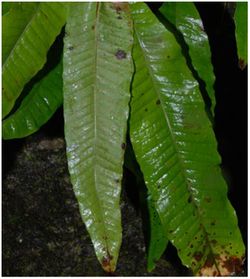 |
Botanical name: Microsorum punctatum (L.) Copel.
Family: Polypodiaceae
Botanical description: Rhizome short creeping, up to 1 cm thick, densely scaly at the apex, sparsely in the rest. Fronds closely arranged in two rows, lanceolate or elliptic, margin entire, stramineous above, rounded below; pinnae dark green when fresh, blackish when dry, glabrous above and below, texture coriaceous. Sori numerous, distributed all over the lower surface of the pinna leaving the basal part; spores yellowish-green, exine finely granulose.
Distribution and ecology: Epiphytes along partially or fully shaded stream banks.
Uses: Leaves and juice are used as purgative, diuretic and wound healer in Ivory Coast (Boquet, 1974).
|
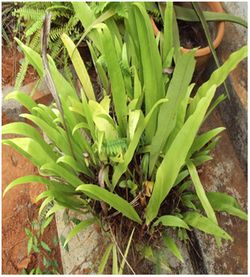 |
Botanical name: Marsilea minuta L.
Family: Marsileaceae
Botanical description: Rhizome long, creeping, branched, subterranean, up to 2mm thick, green in aquatic plants, pale or dark brown in terrestrials, covered by soft, slender hairs sparsely or densely; roots borne usually on nodes. Stipes scattered, usually green, terete. Leaves four, sessile, arranged at the tip of the stipe in clover leaf model, obovate or wedge-shaped; leaves pale or dark green, glabrous with few hairs, texture thin, soft herbaceous. Sporocarps borne at the nodes in clusters alternately, five per cluster, more or less bean-shaped, black or dark brown, very hard; microsporangia and megasporangia enclosed in same sporocarp.
Distribution and ecology: Aquatics or semi-aquatics in marshy places.
Uses: The leaves and sprouts are cooked as vegetable and sold in market (Dixit and Vohra, 1984). Plants are used in cough, spastic condition of leg, muscles and insomnia (Manickam and Irudayaraj, 1992). |
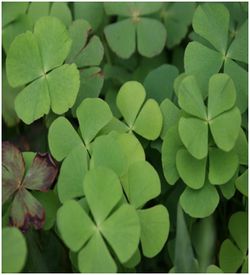 |
Botanical name: Azolla pinnata R. Br.
Family: Azollaceae
Botanical description: Stem horizontal, profusely branched, zig-zag, bearing roots which are densely covered by hairs. Leaves alternate, arise from dorsal lobe, aerial, more or less rectangular, sessile, grey-green, thick, enclosing large mucilage filled cavities that harbour blue-green algae; ventral lobes submerged, margin entire, lobes thin, membranaceous, transparent, brownish, glabrous. Microsporocarpsglobose, brown with two layered wall, containing numerous microsporangia; megasporocarp smaller than microsporocarp, ovate, enclosing single megasporangium.
Distribution and ecology: Free floating, aquatic plants in the plains.
Uses: Used as an important biofertilizer in paddy fields because of presence of blue-green algae. Also known for heavy metal absorptions and employed as cattle feed too at some places.
|
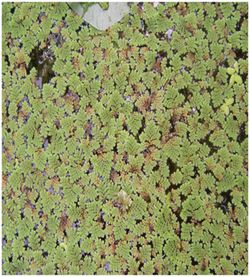 |
|